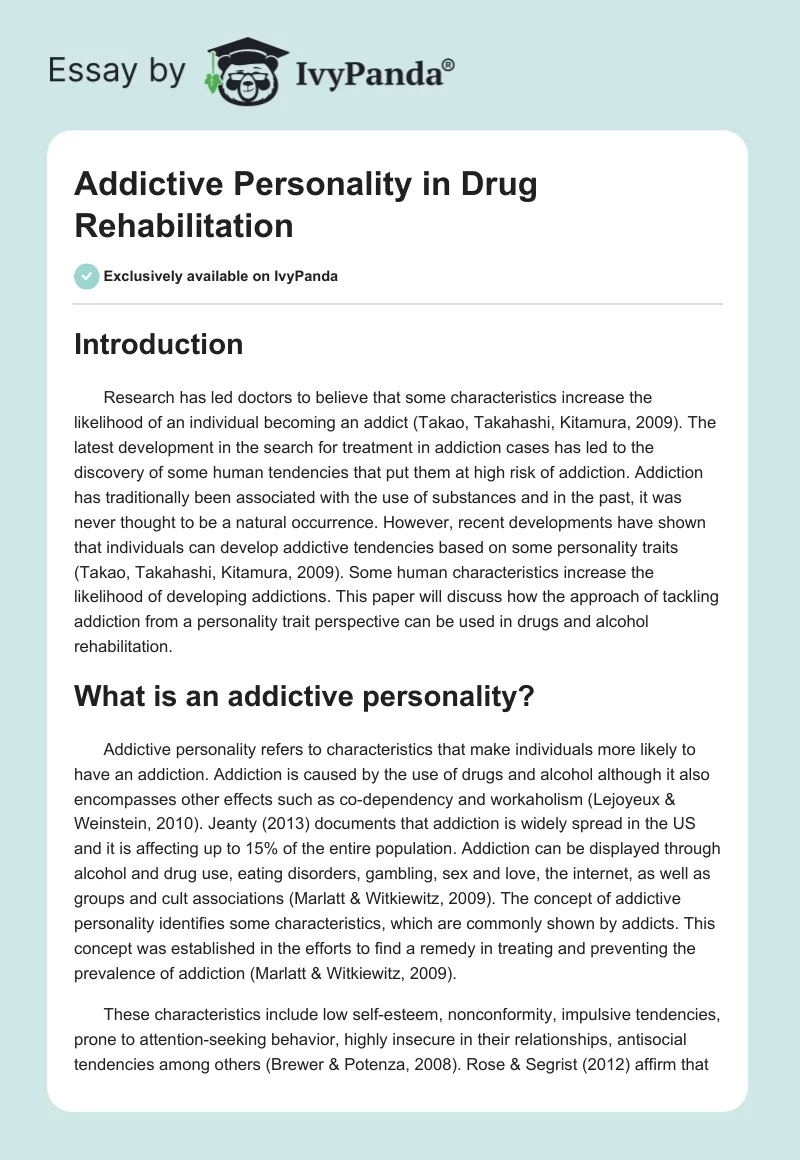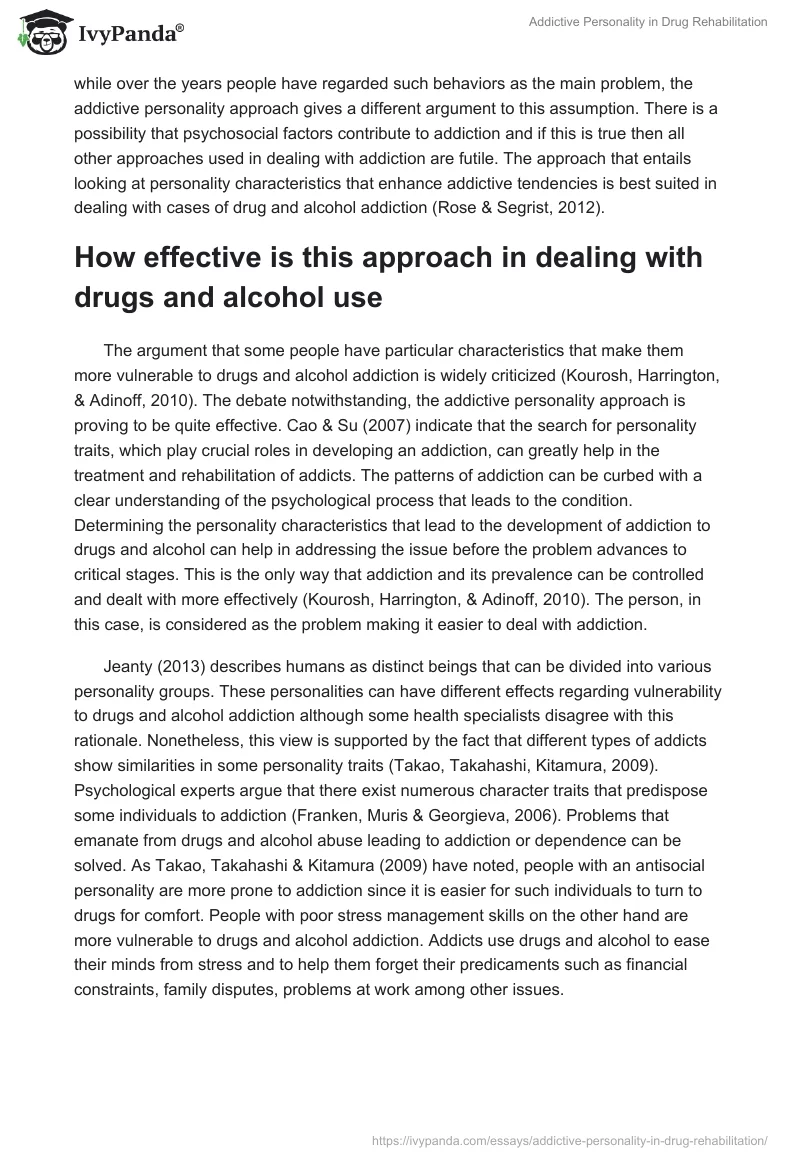Introduction
Research has led doctors to believe that some characteristics increase the likelihood of an individual becoming an addict (Takao, Takahashi, Kitamura, 2009). The latest development in the search for treatment in addiction cases has led to the discovery of some human tendencies that put them at high risk of addiction. Addiction has traditionally been associated with the use of substances and in the past, it was never thought to be a natural occurrence. However, recent developments have shown that individuals can develop addictive tendencies based on some personality traits (Takao, Takahashi, Kitamura, 2009). Some human characteristics increase the likelihood of developing addictions. This paper will discuss how the approach of tackling addiction from a personality trait perspective can be used in drugs and alcohol rehabilitation.
What is an addictive personality?
Addictive personality refers to characteristics that make individuals more likely to have an addiction. Addiction is caused by the use of drugs and alcohol although it also encompasses other effects such as co-dependency and workaholism (Lejoyeux & Weinstein, 2010). Jeanty (2013) documents that addiction is widely spread in the US and it is affecting up to 15% of the entire population. Addiction can be displayed through alcohol and drug use, eating disorders, gambling, sex and love, the internet, as well as groups and cult associations (Marlatt & Witkiewitz, 2009). The concept of addictive personality identifies some characteristics, which are commonly shown by addicts. This concept was established in the efforts to find a remedy in treating and preventing the prevalence of addiction (Marlatt & Witkiewitz, 2009).
These characteristics include low self-esteem, nonconformity, impulsive tendencies, prone to attention-seeking behavior, highly insecure in their relationships, antisocial tendencies among others (Brewer & Potenza, 2008). Rose & Segrist (2012) affirm that while over the years people have regarded such behaviors as the main problem, the addictive personality approach gives a different argument to this assumption. There is a possibility that psychosocial factors contribute to addiction and if this is true then all other approaches used in dealing with addiction are futile. The approach that entails looking at personality characteristics that enhance addictive tendencies is best suited in dealing with cases of drug and alcohol addiction (Rose & Segrist, 2012).
How effective is this approach in dealing with drugs and alcohol use
The argument that some people have particular characteristics that make them more vulnerable to drugs and alcohol addiction is widely criticized (Kourosh, Harrington, & Adinoff, 2010). The debate notwithstanding, the addictive personality approach is proving to be quite effective. Cao & Su (2007) indicate that the search for personality traits, which play crucial roles in developing an addiction, can greatly help in the treatment and rehabilitation of addicts. The patterns of addiction can be curbed with a clear understanding of the psychological process that leads to the condition. Determining the personality characteristics that lead to the development of addiction to drugs and alcohol can help in addressing the issue before the problem advances to critical stages. This is the only way that addiction and its prevalence can be controlled and dealt with more effectively (Kourosh, Harrington, & Adinoff, 2010). The person, in this case, is considered as the problem making it easier to deal with addiction.
Jeanty (2013) describes humans as distinct beings that can be divided into various personality groups. These personalities can have different effects regarding vulnerability to drugs and alcohol addiction although some health specialists disagree with this rationale. Nonetheless, this view is supported by the fact that different types of addicts show similarities in some personality traits (Takao, Takahashi, Kitamura, 2009). Psychological experts argue that there exist numerous character traits that predispose some individuals to addiction (Franken, Muris & Georgieva, 2006). Problems that emanate from drugs and alcohol abuse leading to addiction or dependence can be solved. As Takao, Takahashi & Kitamura (2009) have noted, people with an antisocial personality are more prone to addiction since it is easier for such individuals to turn to drugs for comfort. People with poor stress management skills on the other hand are more vulnerable to drugs and alcohol addiction. Addicts use drugs and alcohol to ease their minds from stress and to help them forget their predicaments such as financial constraints, family disputes, problems at work among other issues.
How the Addictive Approach can work
Acknowledging the different personality traits helps us understand the root cause of an addiction problem hence providing an easier way to address the issue. This approach is effective in dealing with addiction because it focuses on the intrinsic characteristics that enhance the development of an addiction. All humans fall into one category or another in the continuum of addictive personality traits (Jeanty, 2013). Human beings have a propensity to foster behaviors that help them evade pain and suffer in their pursuit of happiness. Jeanty (2013) asserts that the same way we know that with good education we can get a good job and consequently live a better life, knowing the main causes of addiction can help treat and avoid it as well.
Rehabilitating drugs and alcohol addicts takes a wholesome evaluation of the entire problem, which must also include the root cause of the addiction. Personality traits help us to solve the problem from the root cause hence making it the most effective way to deal with addiction. Addicts need to know the role they play in their addiction for them to be able to stop the habit. An isolated individual, for example, is more vulnerable to suffer from stress (Kourosh, Harrington, & Adinoff, 2010). Cao & Su (2007) advise that stress if poorly managed can lead to drugs or alcohol abuse consequently leading to addiction. With such information, potential victims can avoid the habit of isolating themselves. Victims can find alternative ways of keeping themselves busy other than resorting to drugs and alcohol abuse.
For silent and reserved personality, rehabilitation would include encouraging them to get involved in activities that will expose them to interactive activities. Solitude among young people can be reduced by introducing social activities that bring the youths together more often. When young people are trained in alternative and more constructive ways of managing stress, the use of drugs and alcohol could be minimized by a significant percentage. Health experts argue that by recognizing the personality factors that lead to addiction we can device better treatment approaches as well as interventions to hamper the patterns of addiction (Franken, Muris & Georgieva, 2006). Contrary to the common allusion that the personality approach may lead to self-condemnation, acknowledging one’s vulnerability helps him or she devise affirmative actions against addiction (Franken, Muris & Georgieva, 2006).
Conclusion
This paper has discussed and defined addictive personality in a very broad perspective to look at how this approach can be used to reduce addiction cases. In this paper, the war on drugs using the personality approach has been examined to identify whether it is a viable method in fighting drugs and alcohol. The paper argues that there are personality factors that influence addiction and several examples are discussed. Lastly, the effectiveness of this approach in dealing with addiction has been discussed and the paper shows that the addictive personality approach is the most appropriate method in dealing with cases of drugs and alcohol addiction.
References
Brewer, J. A., & Potenza, M. N. (2008). The neurobiology and genetics of impulse control disorders: Relationships to drug addictions. Biochemical Pharmacology, 75 (1): 63–75.
Cao, F., & Su, L. (2007). Internet addiction among Chinese adolescents: Prevalence and psychological features. Child: Care, Health and Development, 33 (3): 275–81.
Franken, I., Muris, P., & Georgieva, I. (2006). Gray’s model of personality and addiction. Addictive Behaviors, 31 (3): 399–403.
Jeanty, J. (2013). Definition of an Addictive Personality. Web.
Kourosh, A. S., Harrington, C.R., & Adinoff, B. (2010). Tanning as a Behavioral Addiction. The American Journal of Drug and Alcohol Abuse, 36 (5): 284–90.
Lejoyeux, M., & Weinstein, A. (2010). Compulsive Buying. The American Journal of Drug and Alcohol Abuse, 36 (5): 248–53.
Marlatt, G. A., & Witkiewitz, K., (2009). Addictive Behaviors. Washington DC, USA: American Psychological Association.
Rose, P., & Segrist, D. J. (2012). Difficulty Identifying Feelings, Distress Tolerance and Compulsive Buying: Analyzing the Associations to Inform Therapeutic Strategies. International Journal of Mental Health and Addiction, 10 (6): 927.
Takao, M., Takahashi, S., Kitamura, M. (2009). Addictive Personality and Problematic Mobile Phone Use, CyberPsychology & Behavior, 12 (5): 501–700.


